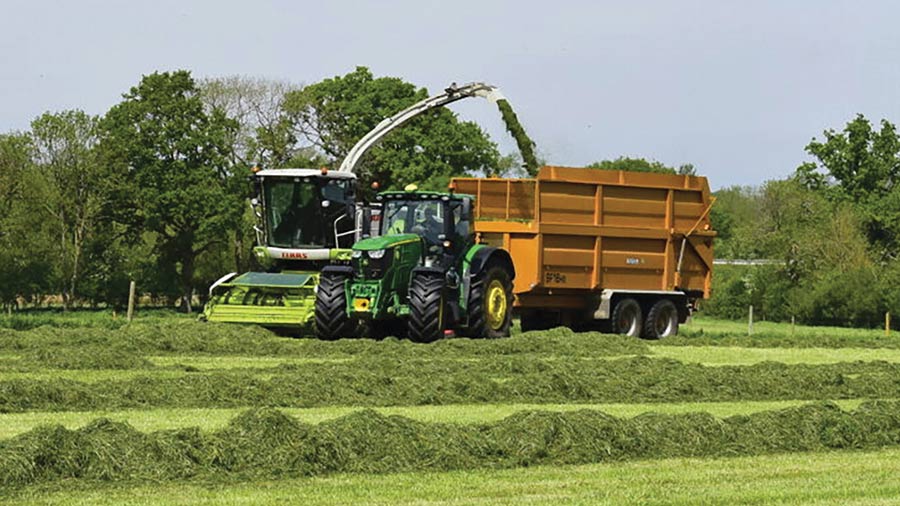Bacterial inoculant boosts milk yield 1.9kg/day, study shows
 © Lallemand
© Lallemand Inoculating silage increases available dry matter, improves aerobic stability, and increases milk yields, according to the findings of a new trial.
The independent trial was carried out at Reading University’s Centre for Dairy Research (Cedar) facility.
It was commissioned by Lallemand Animal Nutrition to test the effects of a bacterial inoculant on forage fermentation, silage aerobic stability and the milking performance of Holstein cows, compared with untreated silage.
See also: 8 ways to produce award-winning silage
The product, Magniva, contains a novel bacterium, Lactobacillus hilgardii, which was first discovered by the company in 2009.
The first stage of the trial was to make the silage, explained Lallemand’s country manager for the UK and Ireland. Lee Gresham, who presented the data at the recent Dairy-Tech event (7 February).
Grass was cut from a single field at the Cedar farm in April 2022. Alternate rows were picked up for each of two 75t clamps. A sample from each trailer was taken for analysis, which showed 28% dry matter (DM).
One clamp was treated with the inoculant (diluted in water and applied atn2g/t during harvesting), while the other was left untreated.
The trial year was a particularly difficult one, with wet weather making the fermentation process a challenge, said Lee.

Untreated silage, left, and treated silage on the right © Lallemand
Dry matter losses
The two silages were assessed after 100 days and researchers found there were significantly higher DM losses in the untreated clamp, resulting in less available feed for the cows.
The untreated clamp had a total of 16,881kg silage (DM) after 100 days, while the treated clamp had 21,781kg – a difference of 29%.
Fermentation analysis results also showed the treated silage had better lactic, acetic and propane-1, 2-diol acid profiles (see “100-day silage analysis results”) and 10 times less butyric acid, compared with the untreated clamp – despite the challenging silaging conditions.
“When you’re bringing in soil with the grass, you’re bringing in [more chance] of clostridia bacteria – the bacteria that causes a lot of spoilage unless the silage is acidified as quickly as possible,” he said.
“High levels can also lead to reduced intake when feeding out.
“Less butyric acid [in the treated silage] suggests better inhibition of clostridia bacteria with [using] the inoculant.”
Aerobic stability
To assess aerobic stability, core samples were taken weekly from the face of each clamp for 12 weeks. Researchers monitored temperature changes within the samples when kept in ambient conditions.
They found the treated clamp was more stable than the control samples: it heated less, and more slowly, resulting in reduced aerobic spoilage.
The control samples took 62 hours to reach a temperature of 2C above ambient, while the treated examples took more than twice as long, at 129 hours.
In practical terms, this meant less energy (in the form of heat) was lost to the environment. This energy could instead be converted to milk when fed to cows, explained Lee.
“The control clamp temperatures peaked at 34.6C, whereas the treated silage reached only 26.7C – a significant difference in energy terms.
“This extra 8C of heating in the control group is the equivalent of losing 28MJ of energy for every tonne of silage fresh weight that is unstable. This equates to 5.4kg of milk lost.”
Lactation performance
The final stage of the trial involved feeding the two silages to cows to see if the treated crop made any difference to lactation performance.
Two groups of 19 cows were used, with each group receiving the treated silage or the control.
Cows were about 84 days in milk at the start of the study and were fed the same diet for 14 days, followed by 70 days on their allocated silage. The diet was formulated to target 7.2kg of grass DM intake.
Because of the increased palatability of the treated silage, DM intake was significantly improved – up 1.5kg a day, compared with the control.
As a result, yields were higher – with fat corrected milk in the treated group averaging 43.7kg a day, compared with 41.8kg a day.
Improvements to protein and fat were also observed (see Feeding trial results table below). “A nice, preserved silage is going to result in better intakes, and that’s exactly what we’ve seen here,” said Lee
100-day silage analysis results |
||
|
|
Untreated silage |
Treated silage |
|
Dry matter (DM) (%) |
22.57 |
26.38 |
|
Crude protein (% DM) |
18.29 |
18.59 |
|
Ash (%) |
13.26 |
13.28 |
|
pH |
3.86 |
3.95 |
|
Lactic acid (%) |
2.89 |
3.81 |
|
Acetic acid (mg/kg) |
2,820 |
6,983 |
|
Propane-1, 2-diol (mg/kg) |
253 |
2,494 |
|
N-butyric acid (mg/kg) |
746 |
70 |
| Source: Lallemand Animal Nutrition/Reading University | ||
Feeding trial results |
||
|
|
Untreated silage |
Treated silage |
|
Dry matter intake (kg/day) |
23.8 |
25.3 |
|
Fat corrected milk (kg/day) |
41.8 |
43.7 |
|
Fat (%) |
4.42 |
4.61 |
|
Protein (%) |
3.39 |
3.49 |
| Source: Lallemand Animal Nutrition/Reading University | ||
